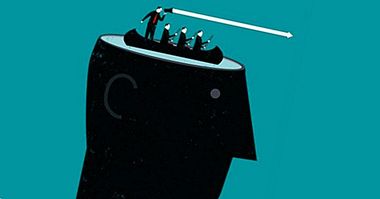Toxic bosses: 11 characteristics that define them
Let's be realistic, there are few individuals who are passionate about going to work and who fully enjoy what they do . Are you one of those who can not stand going to work? Welcome to the club ... because you are not alone. If it is already hard to get up in the morning to take some toast quickly and run to the office, if you have a boss (or boss) who makes sure that the workplace is the closest thing to hell, living is very hard.
Chiefs are of many types , and surely throughout your life you have crossed paths with someone who has embittered your existence. Well today we are going to talk about the toxic heads, those bosses that we do not want to see even in painting.
Toxic bosses negatively affect the welfare of employees
The relationship of superiors with subordinates has been the result of various studies in the workplace, and psychologists of organizations have been interested in this relationship for many reasons, but mainly because A good relationship between managers and employees increases the productivity and results of the company . No less important is knowing that, although many companies do not pay due attention to this phenomenon, the leadership style of superiors affects the welfare of employees.
The well-being of employees is also closely related to the results of the company . And for that reason, organizations should take special care when evaluating this variable, because stress and labor unrest, among other causes, may be the result of a toxic relationship between these actors.
A toxic leadership style and poor leadership skills on the part of superiors can cause phenomena such as role conflict, role ambiguity or role overload, which in turn can provoke negative feelings in employees: want to leave the company or have a poor sense of belonging to the company.

Transformational leadership for better employee welfare
The organizational world has undergone great changes in the last three decades due to globalization, and stress has become a very serious problem for companies. The crisis has created really complicated situations for workers , that have had to adapt to changes and a less secure work environment. Not to say that their expectations are very different from those of just a few decades ago, as well as their needs.
Studies suggest that one of the styles of leadership that best fits the times is the transformational leadership . Transformational leaders employ high levels of communication to achieve the objectives and provide a vision of change that they can transmit to employees. They are great motivators and increase the productivity of the workers they are in charge of. With their charisma they have a great impact on their subordinates and they gain trust, respect and admiration. Quite the opposite that toxic bosses.
Recommended article: "Types of Leadership: The 5 most common leader classes"Four out of ten heads are toxic
And there are more toxic bosses than we think. At least that can be read in the newspaper The world, because one of his articles echoed an affirmation that appears in the book, New management for dummies. According to this text, four out of 10 heads are toxic .
Further, in the same newspaper there is a list of five toxic boss profiles that , according to Ana María Castillo and Juan Carlos Cubeiro, two renowned professionals with extensive experience in the university and business, create a bad work environment and negatively affect employees. They are the following:
- The harasser or bully , characterized by humiliating his subordinates and giving orders abusing his power.
- The microdetallist , who is unable to delegate because he thinks that nobody is up to the task.
- The workaholic , who thinks that work shifts are 24 hours.
- The all-numbers , that only gives value to the economic results.
- The favoritist , which is not fair or impartial.
Characteristics of a toxic boss
But what common characteristics do they show of toxic bosses? These are the 11 characteristic features of bosses who have lost their sense of fairness.
1. They are arrogant and do not communicate well
Toxic bosses are arrogant and do not communicate correctly with subordinates . They think that they are always right and expect others to accept their words just for the sake of being the boss.
2. They do not take into account the needs of employees
Bosses who have lost the sense of their role in the company never take into account the needs of employees , they only think about the numbers.They are not aware that the workers are the engine of the company and, therefore, we must take care of them.
3. They are autocratic
Toxic bosses only allow them to make decisions and set the guidelines without the participation of the group. It is they who concentrate all the power and nobody challenges their decisions.
4. They are easily irritable
Bad bosses have little patience and are easily irritated . Since they are not open to the ideas of others, they do not want to be disturbed. The toxic bosses are not aware that the true wealth of their organization is human capital.
5. They are inflexible
Toxic bosses are mentally closed and panic to change , so they are not very innovative. The lack of innovation, in most cases, makes it difficult to adapt to the modern market and, therefore, the progress of the organization.
6. They are too much controllers
This type of bosses control in excess . That is why, by monitoring each and every one of the tasks performed by their subordinates, they reduce their creative capacity.
7. They do not have confidence in themselves
They may appear to have confidence in themselves, but the reality is that it is not so . A leader with self-confidence is not afraid to delegate when necessary, nor afraid to value the opinions of the group. Their insecurity makes them toxic bosses.
8. They have unreal expectations
Toxic bosses have unrealistic expectations , so they usually demand more than they owe their employees. Not only that, but they are ungrateful when others do things well, since they only focus on the negative.
9. They discriminate
Bosses without style are full of prejudices . In fact, they tend to have a sexist and racist mentality, as well as other discriminatory behaviors.
10. They mismanage time
Planning, both work and time is essential when leading teams, it can be a source of stress if not done correctly. One of the problems of toxic bosses is the inability to manage and prioritize your time in a correct and effective way , which can lead to saturation of tasks and responsibilities. In the end, his poor time management is paid by his subordinates.
11. They do not give rise to creativity
Bad bosses are unable to recognize the talent and creativity of their employees. They are governed by rigid rules and dynamics, without leaving any room for improvisation. This causes employees to have totally mechanical functions and fail to develop their capabilities . It is a common mistake, and the company is the main harmed of this attitude.



















